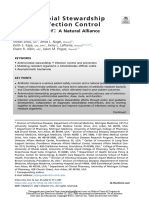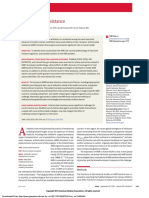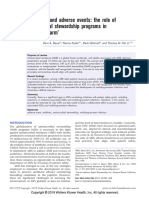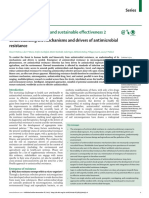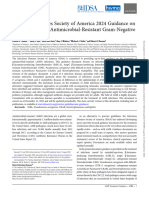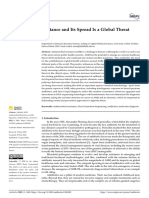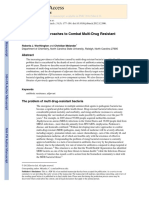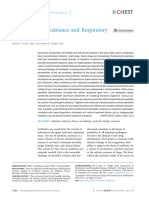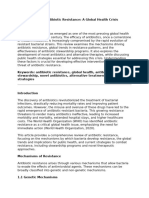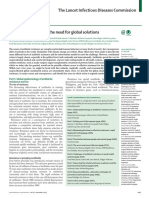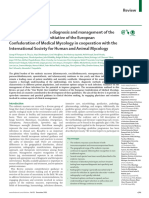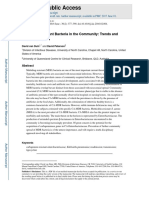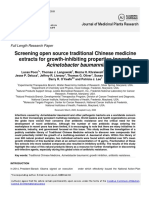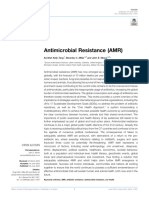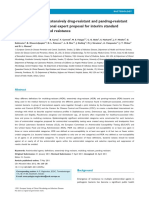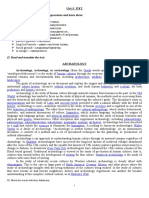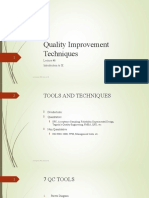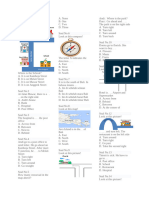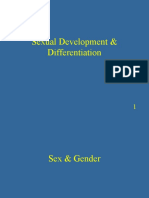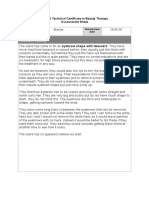Antimicrobial Resistance 2016
Antimicrobial Resistance 2016
Uploaded by
Jovan RadojevićCopyright:
Available Formats
Antimicrobial Resistance 2016
Antimicrobial Resistance 2016
Uploaded by
Jovan RadojevićCopyright
Available Formats
Share this document
Did you find this document useful?
Is this content inappropriate?
Copyright:
Available Formats
Antimicrobial Resistance 2016
Antimicrobial Resistance 2016
Uploaded by
Jovan RadojevićCopyright:
Available Formats
Clinical Review & Education
JAMA | Special Communication
Antimicrobial Resistance
Hilary D. Marston, MD, MPH; Dennis M. Dixon, PhD; Jane M. Knisely, PhD; Tara N. Palmore, MD;
Anthony S. Fauci, MD
CME Quiz at
IMPORTANCE The development of antibiotics is considered among the most important jamanetworkcme.com and
CME Questions page 1209
advances of modern science. Antibiotics have saved millions of lives. However, antimicrobial
resistance (AMR) threatens this progress and presents significant risks to human health.
OBJECTIVE To identify factors associated with AMR, the current epidemiology of important
resistant organisms, and possible solutions to the AMR problem.
DATA SOURCES, STUDY SELECTION, AND DATA SYNTHESIS PubMed (2000-2016), NIH
REPORTER, and ClinicalTrials.gov databases were searched for articles and entries related to
AMR, focusing on epidemiology, clinical effects of AMR, discovery of novel agents to treat
AMR bacterial infections, and nonpharmacological strategies to eliminate or modify AMR
bacteria. In addition to articles and entries found in these databases, selected health policy
reports and public health guidance documents were reviewed. Of 217 articles, databases, and
reports identified, 103 were selected for review.
Author Affiliations: National
RESULTS The increase in AMR has been driven by a diverse set of factors, including inappropriate
Institute of Allergy and Infectious
antibiotic prescribing and sales, use of antibiotics outside of the health care sector, and genetic Diseases, National Institutes of
factors intrinsic to bacteria. The problem has been exacerbated by inadequate economic Health, Bethesda, Maryland
incentives for pharmaceutical development of new antimicrobial agents. A range of specific AMR (Marston, Fauci); Bacteriology and
Mycology Branch, National Institute
concerns, including carbapenem- and colistin-resistant gram-negative organisms, pose a clinical of Allergy and Infectious Diseases,
challenge. Alternative approaches to address the AMR threat include new methods of National Institutes of Health,
antibacterial drug identification and strategies that neutralize virulence factors. Rockville, Maryland (Dixon, Knisely);
National Institutes of Health Clinical
Center, National Institutes of Health,
CONCLUSIONS AND RELEVANCE Antimicrobial resistance poses significant challenges for Bethesda, Maryland (Palmore).
current clinical care. Modified use of antimicrobial agents and public health interventions, Corresponding Author: Hilary D.
coupled with novel antimicrobial strategies, may help mitigate the effect of Marston, MD, MPH, National Institute
multidrug-resistant organisms in the future. of Allergy and Infectious Diseases,
National Institutes of Health,
31 Center Dr, Bldg 31A, Room 7A05C,
JAMA. 2016;316(11):1193-1204. doi:10.1001/jama.2016.11764 Bethesda, MD 20892
(hilary.marston@nih.gov).
A
ntibiotics have revolutionized the practice of medicine by concern. In this regard, the recent global emergence of resistance
enabling breakthroughs across the spectrum of clinical factors emanating from the United States (carbapenem-resistant
medicine, including safer childbirth, surgical procedures, Klebsiella pneumoniae), India (bacteria with the plasmid-mediated
organ transplantation, and myeloablative chemotherapy regi- blaNDM-1 gene that confers resistance to carbapenems),4 and else-
mens. However, antimicrobial resistance (AMR) threatens to im- where (Escherichia coli with the plasmid-mediated mcr-1 gene that
pede and even reverse some of this progress. In the United States, confers resistance to colistin, originally described in China)5 dem-
AMR organisms cause more onstrate the widespread nature of the problem and the impor-
AMR antimicrobial resistance
than 2 million infections and tance of improved global surveillance.
FMT fecal microbiota transplant are associated with approxi- The importance of AMR to human health is clear. In this Special
MRSA methicillin-resistant mately 23 000 deaths each Communication, we review the factors associated with AMR (and ef-
Staphylococcus aureus
year (Table 1).1,2 In Europe, fortstomitigatethem),mechanismsofAMRandtheirinfluenceonclini-
NDM-1 New Delhi AMR is associated with ap- cal practice, and the biomedical research response to the challenge.
metallo-β-lactamase
proximately 25 000 deaths
VIM Verona integron
annually. 3 The economic
metallo-β-lactamase
costs of AMR are substan-
Methods
tial, estimated at $20 billion in excess medical spending each year
in the United States.2 The full global effect of AMR is more difficult The literature of international studies on AMR bacteria was re-
to quantify, as epidemiological data are sparse in many areas of viewed by searching the PubMed database from January 2000 to
the world. However, data that are available represent considerable June 2016. Priority for inclusion in further assessment was based
jama.com (Reprinted) JAMA September 20, 2016 Volume 316, Number 11 1193
Copyright 2016 American Medical Association. All rights reserved.
Downloaded From: http://jamanetwork.com/pdfaccess.ashx?url=/data/journals/jama/935733/ by a NOVARTIS PHARMA AG User on 02/20/2017
Clinical Review & Education Special Communication Review of Antimicrobial Resistance
on peer-reviewed articles and studies that focused on the epide-
miology, microbiology, genomics, and clinical effects of AMR, Key Points
development of vaccines and other therapies to prevent and treat Question What factors are associated with antimicrobial
AMR infections, diagnostic tests to identify AMR and refine use of resistance, and what are the most promising approaches to
antimicrobial drugs, discovery of novel agents to fight AMR bac- address the problem?
terial infections, and nonpharmacological strategies to eliminate
Findings Factors associated with antimicrobial resistance include
or modify AMR bacteria. In addition to articles found in PubMed, human behavior, bacterial genetic factors, and poor economic
selected media reports, public health guidance documents, incentives for innovation. Plasmid-derived antimicrobial resistance
health policy reports, and NIH REPORTER and ClinicalTrials.gov is particularly problematic, given the potential for interspecies
database entries were identified and reviewed because they spread. Innovative approaches, such as novel methods of
described recent trends in AMR. Among 217 identified sources, antibacterial drug identification and immune-based therapies, are
103 were selected for inclusion as references on the basis of qual- being actively pursued.
ity and relevance to understanding the problem and conse- Meaning Antimicrobial resistance requires a multifaceted
quences of AMR, recent key trends and current events in AMR, response, including biomedical research and behavior change by
and efforts under way to address AMR. patients, prescribers, and various industrial sectors (agriculture,
pharmaceuticals).
Factors Associated With AMR and Key Response
also are reports of resistant pathogens passing from humans to
Strategies animals.14 The potential influence of the agricultural use of antibiot-
To adequately address the threat posed by AMR, it is important to ics on human health has drawn a range of responses, including poli-
understand the factors driving its emergence. For example, bac- cies in Europe banning their use for purposes of animal growth,
terial replication cycles enable emergence of de novo mutations: guidance from the FDA encouraging similar avoidance, and volun-
a single Staphylococcus aureus bacterium can replicate through tary sourcing of antibiotic-free meat by a range of food providers.
10 generations in less than 12 hours, producing 1 million progeny.6 In addition, the FDA recently published its Final Rule on Antimicro-
Each replication cycle offers the opportunity for mutation, allow- bial Animal Drug Sales and Distribution Reporting,15 requiring pro-
ing the emergence of genetic factors that contribute to resistance ducers of animal drug products with antimicrobial activity to sub-
to antibiotics. Although de novo mutations can cause new prob- mit annual reports on the amount sold, to improve transparency of
lems today, naturally occurring resistance factors appear to pre- their use.
date the antibiotic era. Permafrost samples from the Yukon Human antibiotic use also contributes to the emergence of
revealed the presence of bacteria with resistance mutations AMR (Figure 1). Substantial effort has addressed inappropriate
30 000 years before the discovery of penicillin.7 Resistance fac- antibiotic use within hospitals, including implementation of antimi-
tors also were identified in samples drawn from a cave ecosystem crobial stewardship programs. Such programs involve collabora-
that was isolated for more than 4 million years.8 Moreover, phylo- tions among infectious diseases specialists and pharmacists with
genetic analyses of β-lactamases (enzymes that render penicillin- training in antimicrobial stewardship, supported by information
like antibiotics ineffective) indicate their emergence 1 billion to management experts. The programs seek to optimize antibiotic
2 billion years ago.9 selection and reduce the inappropriate use of broad-spectrum anti-
Although naturally occurring resistance factors contribute to biotics (use of these agents applies selective pressure to bacteria
AMR, antibiotic use selects for their emergence; therefore, human and promotes emergence of AMR). Stewardship programs typically
activity plays an important role in the evolution of AMR. For are empowered by hospital administrations to restrict the hospital
example, consider the agricultural use of antibiotics for promotion formulary and require preauthorization for restricted antimicrobials
of animal growth. In the United States, antibiotic use in animals or require audits of prescriptions paired with feedback to
raised for food represents 80% of total antibiotic consumption.10 prescribers.20 Although the implementation of hospital antimicro-
The US Food and Drug Administration (FDA) estimates that 74% of bial stewardship programs has thus far been limited, the recent
these antibiotics are administered in feed, a method commonly adoption by the Joint Commission (the primary accrediting body
used to promote animal growth, rather than to treat or prevent for hospitals) of an antimicrobial stewardship standard for health
infection. Moreover, 62% of the antibiotics used in animals in this care facilities may encourage their use.21
country represent “medically important” compounds, ie, they have Although individual studies and programs have demonstrated
a role in treating human disease.11 Antibiotics used in the remaining the potential importance of antimicrobial stewardship in hospitals,
38% may influence human health as well. For example, bacitracin is limited implementation and acceptance continues to hamper sus-
commonly used topically on humans but not systemically adminis- tainable change. However, inpatient antibiotic usage represents
tered as it is in animals. Although the direct influence of such prac- only 38.5% of the total antibiotic market.22 A recent analysis
tices on human health is difficult to quantify, reports of transmis- revealed that 12.6% of outpatient visits in the United States
sion of resistant bacteria via animal-to-human contact and resulted in the prescribing of an antibiotic, and 30% of those pre-
consumption of animal products continue to emerge.12 Further- scriptions may have been inappropriate.23 Direct-to-consumer
more, an association has been demonstrated between antibiotic sales compound the problem of inappropriate use in many areas of
consumption by animals and the existence in humans of commen- the world. Outside of the United States and Europe, such pur-
sal organisms resistant to the same antibiotic classes.13 There chases account for one-fifth to nearly all antibiotic use, depending
1194 JAMA September 20, 2016 Volume 316, Number 11 (Reprinted) jama.com
Copyright 2016 American Medical Association. All rights reserved.
Downloaded From: http://jamanetwork.com/pdfaccess.ashx?url=/data/journals/jama/935733/ by a NOVARTIS PHARMA AG User on 02/20/2017
Review of Antimicrobial Resistance Special Communication Clinical Review & Education
on location.24 Worldwide, antibiotics dispensed directly to the con- ment in new drug development. Limited duration of treatment,
sumer are more likely to be inappropriately selected, taken at relatively low prices per dose, the potential for the rapid emer-
doses below standard of care, or both.24 All of these factors con- gence of resistance (and resulting uncertain market longevity),
tribute to the emergence of AMR. and antimicrobial stewardship efforts that limit access to new
Public education campaigns have exerted a positive influence compounds all may curtail revenue prospects for a new antimi-
on inappropriate prescribing in countries such as Belgium and crobial agent. Clinical trials of new therapeutic candidates for
France.3 For example, a national media campaign in Belgium coin- drug-resistant infections pose their own unique challenges; for
cided with a 36% reduction in antibiotic prescriptions over 7 years example, the sporadic incidence of infections and likelihood of
(although other factors likely contributed as well).3 Other coun- antecedent antibiotic exposure in hospitals complicate enroll-
tries, including the United States, have launched education cam- ment into clinical trials. Antibiotic development for gram-negative
paigns (eg, the Centers for Disease Control and Prevention’s [CDC’s] infections is particularly difficult due to low permeability of the
“Get Smart About Antibiotics Week”25 or the “Medicines With the
Red Line” public awareness campaign in India26). Importantly, these Table 1. Annual Cases and Deaths for Selected Antimicrobial-Resistant
programs are still relatively new and conclusive evidence of their ef- Organisms and Clostridium difficile Infection in the United States,
fectiveness is not yet available. Efforts targeting primary care clini- 2008-2011a
cians also can change practice: a recent randomized clinical trial of Deaths
behavioral interventions (eg, lists comparing levels of inappropri- Cases per Year per Year
ate prescribing among peers) demonstrated statistically significant Streptococcus pneumoniae (resistant to 1.2 million 7000
clinically relevant drugs)
decreases in inappropriate prescribing.27 Similarly, in a cluster ran-
Drug-resistant Campylobacter 310 000 28
domized trial in which investigators offered an educational module
Clostridium difficile 250 000 14 000
and personalized feedback designed to reduce broad-spectrum an-
Drug-resistant Neisseria gonorrhoeae 246 000 <5
tibiotic prescriptions for acute respiratory tract infections in chil-
Drug-resistant nontyphoidal Salmonella 100 000 38
dren, intervention sites demonstrated a 12.5% decline in prescrip-
Methicillin-resistant Staphylococcus 80 461 11 285
tions for broad-spectrum agents compared with a 5.8% decline in aureus
control settings.28 Drug-resistant Shigella 27 000 40
While human behavior contributes to AMR, another human Extended spectrum β-lactamase– 26 000 1700
endeavor—research innovation—provides a means to respond, for producing Enterobacteriaceae
example, through the development of new antibiotics. The pace Carbapenem-resistant 9300 610
Enterobacteriaceae
at which new antibiotics have been introduced has slowed con-
Clindamycin-resistant group B 7600 440
siderably. For example, 16 antibiotics were approved by the FDA Streptococcus
between 1983 and 1987, whereas only 2 were approved between Drug-resistant Acinetobacter 7300 500
2008 and 2012,29 and a total of 5 new antimicrobials have been Multidrug-resistant Pseudomonas 6700 440
approved since the end of 2012.30 This slowdown is not unique to aeruginosa (≥3 drug classes)
a
antibiotics; similar trends were observed for cardiovascular drugs Organisms ordered by number of cases. Methods describing figure derivation
and other agents.31 Nevertheless, certain characteristics of the are described in the technical appendix of the Centers for Disease Control and
Prevention’s Antibiotic Resistance Threats in the United States, 2013.1
antibiotic market likely hinder pharmaceutical industry invest-
Figure 1. Time From Antibiotic Approval or Introduction to Detection of Resistance in Clinical Samples
Year of Approval
or Introduction
Class Antibiotic to Market
β-Lactams Penicillin 1942
Methicillin 1960
Cephalothin 1964
Amoxicillin-clavulanic acid 1984
Carbapenems Imipenem-cilastatin 1985
Amphenicols Chloramphenicol 1950
Tetracyclines Tetracycline 1953
Aminoglycosides Streptomycin 1946
Macrolides Erythromycin 1952
The bars represent the years elapsed
Glycopeptides Vancomycin 1958 between regulatory approval or
Quinolones Nalidixic acid 1964 introduction of an antibiotic to the
Streptogramins Quinupristin-dalfopristin 1999 pharmaceutical market and the first
Oxazolidinones Linezolid 2000 report of resistance in a clinical
Lipopeptides Daptomycin 2003 sample. Displayed antibiotics
represent either first member or
0 5 10 15 20 25 30 35 representative member of the drug
Years From Approval or Introduction to class. Adapted from Schmieder and
Market to First Clinical Report of Resistance Edwards,16 additions from Ayliffe,17
Lee et al,18 and Drugs@FDA.19
jama.com (Reprinted) JAMA September 20, 2016 Volume 316, Number 11 1195
Copyright 2016 American Medical Association. All rights reserved.
Downloaded From: http://jamanetwork.com/pdfaccess.ashx?url=/data/journals/jama/935733/ by a NOVARTIS PHARMA AG User on 02/20/2017
Clinical Review & Education Special Communication Review of Antimicrobial Resistance
gram-negative cell wall, a variety of efflux pumps (which actively
Figure 2. Spread of Plasmid-Based Resistance via Bacterial Conjugation
transport drugs out of the cell), and an array of enzymes capable
of inactivating all known β-lactam drugs (eg, penicillins and 1 Extension of pilus from donor cell and binding to recipient cell
cephalosporins). DONOR
RECIPIENT
Policy interventions offer an important strategy to encourage BACTERIUM
BACTERIUM
AMR gene Plasmid
drug development. For example, 6 new antibacterial drugs have Pilus
DNA
been approved since 2010 under the “Generating Antibiotic Incen- Bacterial
chromosome
tives Now” law in the United States, which grants extended patent Bacterial
chromosome
exclusivity and expedited regulatory review for qualifying
compounds.32 As of March 2016, 37 distinct systemic antibacterial 2 Retraction of pilus and fusion of cell membranes
drugs were reported to be in clinical development for bacterial
infections33 (excluding mycobacterial infections). However, it is note-
worthy that drug candidates for gram-negative infections are scarce,
and this gap merits further policy discussion. For example, at a time
Cleavage of single strand
when several new gram-negative resistance factors are being iden- of plasmid DNA
tified, drugs with activity against one or more of the gram-negative
3 Transfer of single strand of plasmid DNA
ESKAPE pathogens (Enterococcus faecium, S aureus, K pneumo- and replication of complementary strands
niae, Acinetobacter baumanii, Pseudomonas aeruginosa, and
Enterobacter species) represent only one-third of the antibiotics in
clinical development.
While new antibiotic options are critically needed, other ap-
proaches also have an important role. Both ensuring judicious use
and shortening the duration of treatment can reduce antimicrobial 4 Separation of cells
use and reduce the development of AMR.20 Similarly, proven pub-
lic health interventions such as access to clean water and sanita-
tion and hospital infection control can prevent bacterial infections
and obviate the need for some antibiotic use. In addition, vaccines
may have a role: Laxminarayan and colleagues34 estimated that im-
proved vaccination coverage for Streptococcus pneumoniae could
A plasmid containing an antimicrobial resistance (AMR) gene, such as genes for
avert 11.4 million antibiotic days per year in children under 5 years carbapenemases, is able to move from one bacterial species to another via
of age worldwide. bacterial conjugation.
bacteria allowing horizontal gene transfer (Figure 2). Antimicro-
Mechanisms of AMR and Their Influence on
bial resistance genes encoded in bacterial chromosomes, such as
Clinical Practice multidrug efflux pumps in P aeruginosa, are usually not mobile,
While numerous strategies are available to curtail antibiotic de- whereas those that are carried in plasmids can disseminate rap-
mand, an expanding array of resistant organisms poses an immedi- idly among bacteria of the same or different species. Moreover,
ate concern for human health. The organisms and resistance mecha- plasmids often carry multiple AMR genes. At times, these addi-
nisms of greatest concern are detailed below. tional genes are acquired through transposable elements, or
transposons. Transposons are mobile DNA sequences that can
Organisms Resistant to Carbapenems integrate either into the bacterial chromosome or a plasmid,
β-Lactamases are a family of AMR enzymes that hydrolyze β-lactam often carrying AMR genes.
rings, structures present in common antibiotics such as penicil- Chromosomally encoded carbapenemases have been recog-
lins, cephalosporins, and aztreonam. Some are considered nized for decades; however, only within the past 15 years have
“extended-spectrum β-lactamases” because they can inactivate a plasmid-mediated carbapenemases become clinically significant.
wide range of β-lactam antibiotics. Carbapenemases are even Enteric bacteria carrying the K pneumoniae carbapenemase
more versatile members of the β-lactamase family due to their gene (blaKPC) were first reported in the United States in the early
ability to hydrolyze both traditional β-lactam antibiotics and car- 2000s. They became widespread in health care facilities in the
bapenems, the latter representing the broadest-spectrum antibi- northeastern states and then in Israel.35 Within a decade, blaKPC
otics available for treatment of gram-negative bacterial infec- variants and several additional plasmid-carried carbapenemases
tions. Although many β-lactamase genes are encoded in the were identified in other regions of the world, typically in health
bacterial chromosome, extended-spectrum β-lactamase and car- care–associated gram-negative bacteria.36 It soon became appar-
bapenemase genes, which render gram-negative bacteria resis- ent that infections with these multidrug-resistant organisms were
tant to important antibiotic classes, are usually plasmid mediated. associated with mortality rates of 40% to 80%.37-40
Plasmids are typically circular pieces of DNA that are consid- The New Delhi metallo-β-lactamase (NDM-1)–containing bac-
ered mobile because they can be passed between bacteria via teria were identified in India in 20094 and rapidly became endemic
conjugation, a process that briefly connects the cytoplasm of 2 throughout South Asia and the Balkan states. The blaNDM-1 gene
1196 JAMA September 20, 2016 Volume 316, Number 11 (Reprinted) jama.com
Copyright 2016 American Medical Association. All rights reserved.
Downloaded From: http://jamanetwork.com/pdfaccess.ashx?url=/data/journals/jama/935733/ by a NOVARTIS PHARMA AG User on 02/20/2017
Review of Antimicrobial Resistance Special Communication Clinical Review & Education
has now been implicated in nosocomial infections and outbreaks bacteriaceae” (CRE). However, as noted above, the plasmids are
on every inhabited continent.41-43 Bacteria containing the blaNDM-1 often also carried by bacteria outside of the Enterobacteriaceae fam-
gene are so widespread on the Indian subcontinent that they have ily, and clinicians must be aware of this possibility.
been cultured from runoff water on the streets,44 in newborns Acinetobacter baumannii, a common and tenacious nosoco-
delivered in hospitals,45 and in community-acquired infections.46 mial pathogen, is more frequently carbapenem resistant than En-
The blaNDM-1 gene has been identified in a broad range of gram- terobacteriaceae. Although its carbapenem resistance is typically
negative bacteria beyond enteric flora, including Acinetobacter and chromosomally encoded, A baumannii can also carry plasmid-
Pseudomonas.41 mediated carbapenemases. Nosocomial strains of A baumannii are
The plasmid-carried OXA-48 family of carbapenemases first minimally susceptible to newly developed combination antibiotics
appeared in 2001 and have spread around the globe over the past such as ceftolozane-tazobactam, and the antibiotic pipeline does not
15 years. Organisms with these enzymes caused at least 2 clusters appear to offer more effective options,29 making A baumannii a con-
of nosocomial infection in the United States in 2015, as well as doz- tinued major concern for hospitalized patients.
ens of sporadic cases of colonization or infection.47 Other clinically
significant carbapenemase enzymes include imipenemase-1 and Organisms Resistant to Colistin
the Verona integron metallo-β-lactamase (VIM). In 2015, scientists in China identified a plasmid-carried gene con-
In the United States and Europe, carbapenemase-producing ferring resistance to polymyxins such as colistin. 5 The gene,
isolates have been identified predominantly in health care facili- mcr-1, has been found in human and animal isolates of Enterobac-
ties, with rare cases seen in community-acquired infections.48,49 teriaceae and represents the first known plasmid-mediated
Several outbreaks related to contaminated duodenoscopes have resistance to polymyxins, which are antibiotics of last resort for
occurred,50,51 forcing new methods of scope reprocessing and gram-negative bacteria. Although colistin resistance among gram-
reconsideration of scope design. The potential for spread of negative bacteria is not new, the potential epidemiological conse-
carbapenemase-containing plasmids to community-acquired bac- quences of rapid interspecies spread of plasmid-carried colistin re-
terial strains, such as E coli ST131, is a concerning prospect. sistance are concerning. Since its discovery, mcr-1 has been identified
Although little evidence exists for extensive community spread in Enterobacteriaceae cultured from humans, animals, and meat in
outside Asia, the isolation of carbapenemase-producing organ- at least 5 continents, including North America (Figure 3).57,58,60 As
isms from wild birds and other animals demonstrates that the evidenced by an isolate reported from Germany, when this gene finds
bacteria have disseminated to some degree from health care set- its way to a highly resistant carbapenemase-producing organism, the
tings to the environment.52 result would be a pan-resistant organism that is potentially untreat-
Carbapenemase-producing organisms are typically re- able with any existing antimicrobial drugs.61
sistant to all β-lactam drugs, although NDM-1–producing bac-
teria may retain susceptibility to aztreonam. In addition, these Consequences of Empirical Antibiotic Treatment
bacteria often simultaneously carry other plasmid-mediated Other patterns of AMR can have serious consequences, even when
resistance factors. In such cases, tigecycline, polymyxins, and resistance is limited to a single class of drugs. Resistance may com-
aminoglycosides are often the only drugs with activity against plicate early treatment of infection before culture results are known,
these microbes; among these, tigecycline has limited efficacy and such as with empirical therapy for community-acquired pneumo-
its use has been associated with poor clinical outcomes in serious nia or urinary tract infections, as well as for surgical prophylaxis. For
infections.53 Thus, the limited therapeutic options and the toxic- example, fluoroquinolones have long been used as perioperative pro-
ity of the few active drugs are largely responsible for the high phylaxis for patients undergoing transrectal prostate biopsies. In the
mortality rate associated with these infections.37-40 Infections past decade, increasing reports of postprocedure sepsis with fluo-
with highly resistant carbapenemase-producing organisms are roquinolone-resistant E coli have led to new preprocedure selec-
usually treated with combination antibiotic therapy in an attempt tive rectal cultures for such strains, which require an additional visit
to achieve better microbial killing and preserve susceptibility to to the urologist and specialized microbiology testing.62 Alterna-
the few remaining antibiotic options.54 However, repeated expo- tively, some hospitals have broadened surgical prophylaxis to drug
sure to suboptimal antibiotics and inadequate dosing fosters fur- combinations63 such as ceftriaxone and gentamicin that cover fluo-
ther resistance and can result in recrudescent infection due to roquinolone-resistant E coli. However, this approach may select for
extremely drug-resistant bacteria. Newer antimicrobial options, different resistant strains because of the broad-spectrum cover-
such as the β-lactam and β-lactamase–inhibitor combinations age, thereby delaying the clinical consequences of resistance until
ceftazidime-avibactam and ceftolozane-tazobactam offer prom- a later date.
ise for treatment of some carbapenemase-producing organisms.
Their utility may be limited because they are expensive (approxi- The Special Problem of Clostridium difficile
mately $1100 and $315 per day of treatment, respectively), 55 Clostridium difficile is the leading cause of health care–associated
ceftazidime-avibactam lacks activity against metallobetalactama- infections in the United States and is a cause of epidemics of
ses (eg, NDM-1 and VIM), and bacterial resistance to ceftazidime- nosocomial infections.1,64 The bacterium’s resistance to multiple
avibactam has already been reported among blaKPC-containing antibiotics allows its selection for overgrowth in the gut when the
bacteria.56 gut microbiome is disrupted by antibacterial drugs. Clostridium
Thus, a wide array of carbapenamase-carrying plasmids have ap- difficile spores shed by infected or colonized patients persist on
peared with differing effects on clinical practice. This group of re- the surfaces of objects in hospitals and may be ingested by
sistant organisms has been dubbed “carbapenem-resistant Entero- patients receiving antibiotics and other therapies. In addition, the
jama.com (Reprinted) JAMA September 20, 2016 Volume 316, Number 11 1197
Copyright 2016 American Medical Association. All rights reserved.
Downloaded From: http://jamanetwork.com/pdfaccess.ashx?url=/data/journals/jama/935733/ by a NOVARTIS PHARMA AG User on 02/20/2017
Clinical Review & Education Special Communication Review of Antimicrobial Resistance
Figure 3. Recovery of mcr-1–Expressing Resistant Enterobacteriaceae Isolates as of June 21, 2016
The Netherlands
Sweden Belgium
Denmark The Netherlands
Canada United United
Kingdom Germany Kingdom Germany
United Switzerland United France Italy
States Spain China States Spain Tunisia China
Italy Japan
Laos Taiwan
Egypt Algeria Egypt Laos
Thailand Vietnam Vietnam
Cambodia
Malaysia
Malaysia Brazil
South Africa South Africa
Argentina
Isolates from humans Isolates from animals used for food
The Netherlands
United Denmark
Canada
Kingdom France Switzerland
Switzerland
Portugal China
Taiwan
Malaysia
Isolates from food Isolates from the environment
The figure depicts the identification of mcr-1–expressing isolates from various from Skov and Monnet58 and the US Department of Health and Human
specimen types (human, animals used for food, food, environment) by country. Services59 and adapted under a Creative Commons Attribution (CC BY) license.
Data from the European Centre for Disease Prevention and Control,57 updated
hypervirulent strain BI/NAP1/027 possesses increased resistance importance of prevention. Newer antimicrobials, such as fidaxomi-
to fluoroquinolones,65 giving it a selective advantage in patients cin, have some efficacy both in treatment of infection and preven-
treated with that class of antimicrobials. Clostridium difficile bac- tion of relapse. Severe or fulminant disease that does not respond
teria are generally not invasive; however, these organisms elab- to vancomycin or fidaxomicin may be treated surgically. Fecal mi-
orate exotoxins (toxins A and B) that cause mucosal damage in crobiota transplant (FMT), or transfer of stool from an individual with
the colon leading to the morbidity of the infection. The disease a healthy fecal microbiome, is an evidence-based and highly effec-
manifests as colitis with diarrhea and classically a colonic pseudo- tive treatment, with success rates of 81% to 94%.72 The high effi-
membrane; in a recent multicenter study, 8% of patients with cacy of FMT has made it a standard approach and an often wel-
C difficile infection developed severe complications such as toxic come intervention for patients with recurrent relapses or refractory
megacolon.66 disease.72 A variety of preventive agents for C difficile are in clinical
The rate of C difficile infection among hospitalized patients in trials, including vaccines, monoclonal antibodies, therapeutic agents
the United States nearly doubled from 2001 to 2010,67 peaked in such as nontoxigenic strains (to prevent recurrence),73 and toxin-
2011 at roughly 147 cases per 100 000 population, and has binding compounds.
declined slightly since.68 The United Kingdom, in contrast, has
seen a decline in C difficile infection rates of more than 75% since Neisseria gonorrhoeae
2007 (from 108 to 26 cases per 100 00069), likely attributable to Another resistant organism causing increasing concern is Neisse-
successful preventive measures including antimicrobial steward- ria gonorrhoeae. Gonorrhea is the second most common report-
ship, strict mandatory infection control precautions, environmen- able communicable disease in the United States (after chlamydial
tal cleaning to eliminate spores, and patient-level analysis of the disease).74 Neisseria gonorrhoeae has developed increasing resis-
failures and factors precipitating individual cases of C difficile tance to oral antibiotics (eg, azithromycin, fluoroquinolones, and
infection.70 the oral cephalosporin cefixime) previously used to treat this
Clostridium difficile infection is usually treatable with antimi- infection; in 2014, 37% of N gonorrhoeae isolates in the United
crobials, such as oral metronidazole for mild to moderate infection States were resistant to at least 1 antibiotic.75 Although cefixime
and oral vancomycin for more severe infection.71 Recurrent dis- resistance in the United States has declined in recent years,76 the
ease occurs in approximately 20% of patients,68,71 underscoring the slow, inexorable rise in resistance of N gonorrhoeae has resulted
1198 JAMA September 20, 2016 Volume 316, Number 11 (Reprinted) jama.com
Copyright 2016 American Medical Association. All rights reserved.
Downloaded From: http://jamanetwork.com/pdfaccess.ashx?url=/data/journals/jama/935733/ by a NOVARTIS PHARMA AG User on 02/20/2017
Review of Antimicrobial Resistance Special Communication Clinical Review & Education
in increasingly narrow treatment options and has led the CDC to
Table 2. Novel Approaches to Address Antimicrobial Resistance
declare drug-resistant N gonorrhoeae one of the leading microbial
threats to public health.1 Type of Approach Representative Examples
Increasing rates of resistance to oral agents have left ceftriax- Antibiotic Discovery
one as the last remaining reliable treatment for gonorrhea.74 Resis- New ways to identify natural iChip technology: drug screening that
antibiotics mirrors physiologic conditions
tance to ceftriaxone has been reported,77,78 foreshadowing the need Untapped sources of natural Marine microbes living in extreme
for escalation of doses and new drug combinations to overcome re- products conditions
sistance. Treatment guidelines reflect these changes as they move Antimicrobial peptides Bacteriocins (peptides produced by
bacteria) with bacteriocidal activity
toward use of drug combinations.74 Current recommended first-
Harnessing the Immune System
line therapy for gonorrhea in the United States is ceftriaxone plus
Vaccines Vaccines against major causes
azithromycin, even if nucleic acid testing is negative for Chlamydia of health care–associated infections
trachomatis.74 Recent clinical studies have identified drug combina- (eg, Staphylococcus)
tions that could be used for salvage treatment of nonresponders, Monoclonal antibody Under development for severe infections
development with Pseudomonas or Staphylococcus
such as azithromycin in combination with either gentamicin or
Innate immune modulators Products that enhance beneficial or
gemifloxacin.79 Although treating on the basis of antimicrobial sus- suppress deleterious immune responses
(eg, molecules that modulate
ceptibility of N gonorrhoeae in individual patients might help pre- toll-like-receptor 4/lipopolysaccharide
serve the long-term effectiveness of the remaining antimicrobial interactions)
armamentarium,80 rapid molecular detection of resistance is not Manipulating Microbial Communities
available for this organism. Treatment for N gonorrhoeae must be pro- Fecal microbiota transplant Used for Clostridium difficile infections;
under exploration for other indications
vided promptly at the point of care to ensure adherence and mini-
Live biotherapeutics Drug products composed of specific
mize transmission. and characterized live organisms
(eg, for C difficile)
Staphylococcus aureus Bacteriophages Topical treatment for bacterial infection
in burn victims
For the past 2 decades, methicillin-resistant Staphylococcus aureus
Antivirulence Strategies
(MRSA) has been a leading public health concern. MRSA is second
Toxins Antitoxin antibodies for C difficile
only to C difficile as a cause of health care–associated infections.64 treatment
In the early 2000s, the community-acquired strain USA300 be- Secretion systems Secretion system inhibitors which block
secretion of bacterial virulence factors
came the dominant etiology of skin and soft tissue infections in com- (eg, for Pseudomonas infection)
munity settings. Methicillin resistance is conferred by the mecA Biofilm formation Device coatings; compounds that inhibit
gene; many MRSA isolates also contain β-lactamases and genes con- bacterial growth by blocking
communication (quorum sensing)
ferring resistance to clindamycin.
Rapid Diagnostics
For decades, vancomycin was the only available, effective in-
Point of care Tests to distinguish bacterial and viral
travenous therapy for MRSA infections. Isolates of MRSA with re- causes of respiratory illness; rapid tests for
duced susceptibility to vancomycin, known as vancomycin- drug resistance (eg, for gonorrhea)
intermediate S aureus, have been identified infrequently in clinical Culture independent Magnetic resonance technology;
transcriptional profiling
infections. Vancomycin-intermediate S aureus strains have thick- Biomarkers Serum procalcitonin which indicates
ened cell walls that contain vancomycin-binding dipeptides, which bacterial infection
detain the drug and lead to reduced drug at the target.81
The identification of vancomycin-resistant S aureus in clinical treat vancomycin-resistant S aureus if it becomes a more wide-
isolates in the early 2000s was not entirely unexpected: the spread challenge.
plasmid-mediated vancomycin-resistance gene, vanA, is regularly
found in health care–associated isolates of vancomycin-resistant
enterococci. Therefore, ample opportunity exists for gene transfer
The Scientific Pathway Forward
from vancomycin-resistant enterococci to S aureus in patients or
settings where the organisms coexist. While this intergenus trans- Since bacterial resistance to antibiotics is inevitable, researchers must
fer has occurred, it has been documented thus far in only a handful respond with innovative strategies to identify and develop new drug
of identified cases.82 Given the mobility of plasmid DNA, it is candidates, vaccines, and other prophylactic immune interven-
unclear why vancomycin-resistant S aureus infections have tions and create novel treatment methods that are less likely than
remained so uncommon. typical antibiotics to result in resistance (Table 2).
Multiple drugs are available to treat MRSA; however, few are rec-
ommended for treatment of deep-seated infections involving inte- Technologies to Facilitate Drug Discovery and Development
rior bodily structures such as endocarditis and osteomyelitis.83 Over One reason for the limited number of new antibiotics is that tradi-
the past 15 years, new drugs such as daptomycin, linezolid, and ori- tional sources of these products have been carefully evaluated to
tavancin have become available for treatment of serious resistant the point that virtually all promising antibacterial compounds have
gram-positive infections, offering alternatives to vancomycin (in been identified. These sources include chemical libraries used by
countries where these newer, expensive drugs are obtainable). Al- pharmaceutical companies and the small proportion of antibiotic-
though resistance to the newer drugs has been reported, they re- yielding bacteria and fungi that can be easily cultured. To improve
tain considerable activity against MRSA and have the potential to this situation, investigators are developing new tools to identify novel
jama.com (Reprinted) JAMA September 20, 2016 Volume 316, Number 11 1199
Copyright 2016 American Medical Association. All rights reserved.
Downloaded From: http://jamanetwork.com/pdfaccess.ashx?url=/data/journals/jama/935733/ by a NOVARTIS PHARMA AG User on 02/20/2017
Clinical Review & Education Special Communication Review of Antimicrobial Resistance
sources of naturally occurring antibiotics, such as the iChip plat- Manipulating Microbial Communities to Counteract
form that facilitates screening of natural products from previously Resistant Infections
unculturable soil organisms by mimicking their native environment.84 The diverse communities of microbes that inhabit the human body
Using this technology, researchers identified teixobactin, an antibi- (the microbiota) support human health in multiple ways and play cru-
otic compound with a novel mechanism of action. Although teixo- cial roles in protection against infectious diseases. The elements of
bactin is still in the early stages of development, this experience sug- the microbiota are diverse and include bacteria, fungi, and viruses.
gests that the iChip technology could prove an effective way to The potential to manipulate the microbiota to treat infection has al-
identify new classes of antibiotics. Investigators are also exploring ready been demonstrated with the successful use of FMTs for treat-
other untapped sources of products such as marine microbes and ment of C difficile infections. Use of this procedure to decolonize pa-
bacteria living in extreme conditions. Furthermore, antimicrobial pep- tients with multidrug-resistant organisms is the subject of active
tides known as bacteriocins, produced by bacteria, are being evalu- investigation.94 For example, researchers are working to translate
ated for activity and feasibility as products.85 Although these new the therapeutic potential of FMT into live biotherapeutic products,
approaches to drug therapy hold promise, drug screening also could or drug products composed of specific and characterized live
be improved with methods that better model physiologic organisms.95
conditions.86 Although the gut microbiome is the farthest along as a target
for prevention and treatment of infection, there is potential in ex-
Harnessing the Immune System panding these approaches to treat infections at other colonized sites,
Vaccines capable of preventing bacterial infection, disease, or both such as the skin or respiratory tract. Other types of innovative live
circumvent the problem of AMR and have been successfully devel- biotherapeutic concepts are also being explored, such as exploit-
oped for several bacterial pathogens.87,88 However, the develop- ing Bdellovibrio and Micavibrio bacteria that parasitize gram-
ment of vaccines for health care–associated bacterial pathogens has negative pathogens.96
been challenging, due to inadequate understanding of immune cor- Bacteriophages, viruses that infect and kill bacteria with high
relates of protection, complex pathogenic mechanisms, and exten- specificity, also represent a promising tool for addressing AMR.
sive strain and antigenic variability. In this regard, several staphylo- Clinicians have sought to exploit the potential of bacteriophages to
coccal vaccine development programs have failed at the phase 3 treat bacterial infections since their discovery in the early 1900s.
stage of clinical trials, despite promising preclinical and early clini- From the early 1920s through the 1930s, phages were pursued as
cal data.89,90 However, a number of vaccine candidates for health medical interventions for wound infection, dysentery, cholera, and
care–associated infections remain in clinical development and, if suc- plague. With the introduction of broad-spectrum antibacterial
cessful, would likely be deployed in targeted populations of at-risk drugs, phage therapy fell out of favor in the United States and
individuals.91 Western Europe but continued to be used in Russia and Eastern
Passive infusion of monoclonal antibodies provides additional Europe. However, most studies using phage therapy were not done
options for treatment and prevention. Monoclonal antibodies are in accordance with modern clinical trial standards, raising questions
being developed for use in combination with antibiotics in severely about efficacy. Nevertheless, the clinical results were promising,
ill patients with certain bacterial infections (eg, S aureus and particularly with antibiotic-resistant suppurative infections.97 The
P aeruginosa), as well as for prophylactic use. The low toxicity potential application of phage therapy to drug-resistant infections,
and long serum half-lives of certain monoclonal antibodies as well as well as its pathogen specificity, has led to a resurgence of efforts
as the absence of conventional, drug-mediated selective pressure to evaluate this approach for the prevention and treatment of bac-
when they are used as antimicrobials make them attractive terial infections. Recent randomized, double-blind, placebo-
options, especially for prophylaxis. Monoclonal antibodies are par- controlled studies of phage therapy in patients in the United King-
ticularly promising for patient populations with suboptimal dom with chronic, antibiotic-resistant P aeruginosa infections have
responses to vaccination because of immune compromise, shown significant clinical benefit,98 and an ongoing clinical trial in
immune senescence, or other conditions. In addition, bispecific Europe is evaluating the effectiveness of phage therapy to treat
antibodies that can simultaneously bind pathogens and activate burns and wounds.99
T cells have been developed for use against tumors and virus- Innovative phage-derived modalities also are being developed
infected cells.92 In the future, such innovations could be adapted to and evaluated. Lysins are lytic enzymes produced by phages that se-
target bacterial infections. lectively destroy specific gram-positive pathogens with high speci-
Furthermore, considerable progress has been made in identi- ficity and disperse biofilms. The first commercially developed thera-
fying the signaling pathways and receptors of the innate immune peutic product of this type,100 which targets S aureus, is currently
system. Investigators have identified new potentiators of innate im- in phase 1 clinical trials. Investigators are also using phages as a start-
munity that may be effective as vaccine adjuvants or directly as thera- ing point to develop engineered products that can modulate bac-
peutic modalities. Such immune enhancements could lessen the re- terial cells, including their antibiotic-resistance mechanisms and viru-
quired antibiotic dose, treatment duration, or both, thereby lence factors.
decreasing selective pressure toward resistance. Some prospects in- Other innovative tools being explored for their ability to target
clude broadly active innate immune–based strategies such as de- resistant bacteria are systems that likely evolved to protect bacte-
fensins, bactericidal/permeability–inducing protein, engineered ria from phages: CRISPR (clustered regularly interspaced short pal-
γ-core motif peptides or peptidomimetics, complement, compo- indromic repeats)–Cas systems, capable of precise genome edit-
nents of mucosal secretions including surfactant, and inflamma- ing. For instance, in enterococci, multidrug-resistant phenotypes
tion resolving mediators.93 seem to be correlated with the loss of functional CRISPR systems,
1200 JAMA September 20, 2016 Volume 316, Number 11 (Reprinted) jama.com
Copyright 2016 American Medical Association. All rights reserved.
Downloaded From: http://jamanetwork.com/pdfaccess.ashx?url=/data/journals/jama/935733/ by a NOVARTIS PHARMA AG User on 02/20/2017
Review of Antimicrobial Resistance Special Communication Clinical Review & Education
suggesting that some bacteria may trade their CRISPR defense sys- to enable pathogen detection directly from a blood sample and
tem for enhanced ability to acquire new resistance traits through eliminate the need for a culture step. In addition, distinguishing
horizontal gene transfer. Some investigators have proposed taking between colonization and infection at nonsterile sites presents a
advantage of this observation by using phages to specifically de- distinct technical challenge. For example, in respiratory tract infec-
liver CRISPR systems to target resistance genes, ensuring that only tions, detected organisms may not be the cause of the patient’s
resistant strains are targeted.101 symptoms. To circumvent these issues, researchers are developing
tests based on host response expression signatures, which could
Antivirulence Strategies help distinguish colonization from infection and bacterial from viral
Factors that contribute to pathogen virulence—such as toxins, iron infections.102 Biomarkers, such as procalcitonin, are used in some
acquisition systems, secretion systems, quorum-sensing pathways, countries as surrogates of infection to support microbial diagnosis,
adhesins, and biofilm formation—have the potential to be exploited and they are also being explored as tools to help guide initiation of
as novel therapeutic targets. Selectively targeting virulence factors empirical therapy.103
is attractive because this strategy does not affect microbe viability Commercial developers of rapid diagnostics also encounter prac-
and thus does not exert the selective pressure associated with con- tical challenges with clinical validation of their tests, such as access
ventional antimicrobials. The goal of antivirulence therapeutics is to to clinical isolates for test validation. Recently, resources such as the
reduce pathogenicity while allowing the host to clear the bacterial CDC-FDA Isolate Bank and the Antibiotic Resistance Leadership
infection. This approach has the added benefit of preserving the Group Virtual Repository have been established to provide well-
host microbiota. However, new preclinical testing approaches and characterized panels of clinical isolates. Furthermore, the Antibi-
models will need to be developed if antivirulence therapeutics are otic Resistance Leadership Group plans to develop master proto-
to be advanced to the clinic. For example, animal efficacy models cols for diagnostics in which the same group of patients can be used
will need to more accurately reflect clinical progression of disease to validate multiple diagnostic tests simultaneously.
and new in vitro assays will need to be developed.
Diagnostics
Looking Ahead
In addressing the problem of AMR, the importance of rapid diag-
nostics for optimal stewardship of antibiotics cannot be overstated. Although advances in biomedical research hold promise for efforts
Although mass spectrometry has sped identification of bacteria to prevent and treat AMR, many of these technologies are in the ear-
and fungi, this technology as well as antimicrobial susceptibility liest stages of discovery. Meanwhile, effective action can slow the
testing are still largely dependent on culture. Therefore, empirical spread and mitigate the negative effects of resistant bacteria today.
therapy with broad-spectrum antibiotics is often initiated before Medical professionals and facilities have an important role to play,
this critical information is available. Requirements for an optimal through implementation of antimicrobial stewardship programs, re-
diagnostic test differ depending on the clinical setting. In an inpa- duction in inappropriate prescribing, immunization against bacte-
tient setting, a test with a turnaround time of several hours may be rial and viral pathogens, and robust infection control measures in-
sufficient, whereas outpatient settings may require a simple point- cluding enhanced surveillance for resistant organisms. National plans,
of-care test that can provide results while the patient waits—ideally such as the President’s National Strategy for Combating Antibiotic
for less than 30 minutes. Differences also exist in the technical Resistant Bacteria, lay out more comprehensive approaches, draw-
challenges for typically sterile vs nonsterile clinical specimens. For ing on contributions from health care practitioners, biomedical re-
example, bacterial bloodstream infections can be difficult to detect searchers, and the pharmaceutical and agricultural sectors (among
due to the low number of organisms present in the blood; all cur- others).2 Analogous international efforts, overseen by the World
rently FDA-cleared tests for this indication require some culture Health Organization, are also under way. These programs require
prior to identification. However, several companies are exploiting committed and concerted implementation to realize their promise.
new sensitive technologies, such as magnetic resonance technol- Without a coordinated response, the postantibiotic age presaged by
ogy, fluorescence in situ hybridization, and transcriptional profiling so many is a distinct and unwelcome possibility.
ARTICLE INFORMATION Conflict of Interest Disclosures: All authors have Microbiology and Infectious Diseases, National
Author Contributions: Dr Marston had full access completed and submitted the ICMJE Form for Institute of Allergy and Infectious Diseases,
to all of the data in the study and takes Disclosure of Potential Conflicts of Interest and National Institutes of Health. François Franceschi,
responsibility for the integrity of the data and the none were reported. PhD, Therapeutics Development, Bacteriology and
accuracy of the data analysis. Additional Contributions: We thank the following Mycology Branch of the Division of Microbiology
Study concept and design: All authors. individuals for their helpful input in the preparation and Infectious Diseases, National Institute of
Acquisition, analysis, or interpretation of data: of this manuscript: Gregory K. Folkers, MS, MPH, Allergy and Infectious Diseases, National Institutes
Marston, Dixon, Palmore, Knisely. National Institute of Allergy and Infectious of Health.
Drafting of the manuscript: All authors. Diseases, National Institutes of Health. Baoying Liu,
Critical revision of the manuscript for important PhD, MHS, Bacteriology and Mycology Branch of REFERENCES
intellectual content: All authors. the Division of Microbiology and Infectious 1. Centers for Disease Control and Prevention.
Administrative, technical, or material support: Diseases, National Institute of Allergy and Antibiotic Resistance Threats in the United States,
Marston, Dixon. Infectious Diseases, National Institutes of Health. 2013. http://www.cdc.gov/drugresistance/threat
Study supervision: Fauci. Stephanie M. Coomes, PhD, and Christina -report-2013/. Accessed January 12, 2016.
McCormick, MA, both of the Office of Scientific 2. President’s Council of Advisors on Science and
Coordination and Program Operations, Division of Technology. Report to the President on combating
jama.com (Reprinted) JAMA September 20, 2016 Volume 316, Number 11 1201
Copyright 2016 American Medical Association. All rights reserved.
Downloaded From: http://jamanetwork.com/pdfaccess.ashx?url=/data/journals/jama/935733/ by a NOVARTIS PHARMA AG User on 02/20/2017
Clinical Review & Education Special Communication Review of Antimicrobial Resistance
antibiotic resistance. https://www.whitehouse.gov 18. Lee EH, Nicolas MH, Kitzis MD, Pialoux G, .GFOk734M.dpbs. Published March 12, 2015.
/sites/default/files/microsites/ostp/PCAST/pcast Collatz E, Gutmann L. Association of two resistance Accessed June 21, 2016.
_amr_jan2015.pdf. Published September 2014. mechanisms in a clinical isolate of Enterobacter 33. The Pew Charitable Trusts. Antibiotics currently
Accessed January 16, 2016. cloacae with high-level resistance to imipenem. in clinical development. http://www.pewtrusts.org
3. Gelband H, Miller-Petrie M, Pant S, et al. State of Antimicrob Agents Chemother. 1991;35(6):1093-1098. /en/multimedia/data-visualizations/2014
the World's Antibiotics, 2015. Washington, DC: 19. US Food and Drug Administration. Drugs@FDA: /antibiotics-currently-in-clinical-development.
Center for Disease Dynamics, Economics, and FDA Approved Drug Products. https://www Published 2015. Accessed June 16, 2016.
Policy; 2015. http://cddep.org/publications/state .accessdata.fda.gov/scripts/cder/drugsatfda/. 34. Laxminarayan R, Matsoso P, Pant S, et al.
_worlds_antibiotics_2015#sthash.l18BFUu2.dpbs. Published 2016. Accessed June 21, 2016. Access to effective antimicrobials: a worldwide
Accessed January 6, 2016. 20. Barlam TF, Cosgrove SE, Abbo LM, et al. challenge. Lancet. 2016;387(10014):168-175.
4. Yong D, Toleman MA, Giske CG, et al. Implementing an antibiotic stewardship program: 35. Leavitt A, Navon-Venezia S, Chmelnitsky I,
Characterization of a new metallo-β-lactamase guidelines by the Infectious Diseases Society of Schwaber MJ, Carmeli Y. Emergence of KPC-2 and
gene, blaNDM-1, and a novel erythromycin esterase America and the Society for Healthcare KPC-3 in carbapenem-resistant Klebsiella
gene carried on a unique genetic structure in Epidemiology of America. Clin Infect Dis. 2016;62 pneumoniae strains in an Israeli hospital. Antimicrob
Klebsiella pneumoniae sequence type 14 from India. (10):e51-e77. Agents Chemother. 2007;51(8):3026-3029.
Antimicrob Agents Chemother. 2009;53(12):5046- 21. Joint Commission. Approved: new antimicrobial
5054. 36. Guh AY, Bulens SN, Mu Y, et al. Epidemiology of
stewardship standard. https://www carbapenem-resistant Enterobacteriaceae in 7 US
5. Liu YY, Wang Y, Walsh TR, et al. Emergence of .jointcommission.org/new_antimicrobial communities, 2012-2013. JAMA. 2015;314(14):1479-
plasmid-mediated colistin resistance mechanism _stewardship_standard/. Published July 19, 2016. 1487.
mcr-1 in animals and human beings in China: Accessed August 24, 2016.
a microbiological and molecular biological study. 37. Ben-David D, Kordevani R, Keller N, et al.
22. Suda KJ, Hicks LA, Roberts RM, Hunkler RJ, Outcome of carbapenem-resistant Klebsiella
Lancet Infect Dis. 2016;16(2):161-168. Danziger LH. A national evaluation of antibiotic pneumoniae bloodstream infections. Clin Microbiol
6. Pray L. Antibiotic resistance, mutation rates and expenditures by healthcare setting in the United Infect. 2012;18(1):54-60.
MRSA. Nature Educ. 2008;1(1):30. States, 2009. J Antimicrob Chemother. 2013;68(3):
715-718. 38. Mathers AJ, Cox HL, Kitchel B, et al. Molecular
7. D’Costa VM, King CE, Kalan L, et al. Antibiotic dissection of an outbreak of carbapenem-resistant
resistance is ancient. Nature. 2011;477(7365):457- 23. Fleming-Dutra KE, Hersh AL, Shapiro DJ, et al. enterobacteriaceae reveals intergenus KPC
461. Prevalence of inappropriate antibiotic prescriptions carbapenemase transmission through a
8. Bhullar K, Waglechner N, Pawlowski A, et al. among US ambulatory care visits, 2010-2011. JAMA. promiscuous plasmid. MBio. 2011;2(6):e00204-
Antibiotic resistance is prevalent in an isolated cave 2016;315(17):1864-1873. e00211.
microbiome. PLoS One. 2012;7(4):e34953. 24. Morgan DJ, Okeke IN, Laxminarayan R, 39. Satlin MJ, Calfee DP, Chen L, et al. Emergence
9. Hall BG, Salipante SJ, Barlow M. Independent Perencevich EN, Weisenberg S. Non-prescription of carbapenem-resistant Enterobacteriaceae as
origins of subgroup Bl + B2 and subgroup B3 antimicrobial use worldwide: a systematic review. causes of bloodstream infections in patients with
metallo-β-lactamases. J Mol Evol. 2004;59(1):133- Lancet Infect Dis. 2011;11(9):692-701. hematologic malignancies. Leuk Lymphoma. 2013;
141. 25. Centers for Disease Control and Prevention. 54(4):799-806.
10. Van Boeckel TP, Brower C, Gilbert M, et al. Get Smart About Antibiotics Week. https://www 40. Snitkin ES, Zelazny AM, Thomas PJ, et al; NISC
Global trends in antimicrobial use in food animals. .cdc.gov/getsmart/week/. Published February Comparative Sequencing Program Group. Tracking
Proc Natl Acad Sci USA. 2015;112(18):5649-5654. 2016. Accessed August 24, 2016. a hospital outbreak of carbapenem-resistant
11. US Food and Drug Administration. 2014 26. Travasso C. India draws a red line under Klebsiella pneumoniae with whole-genome
Summary report on antimicrobials sold or antibiotic misuse. BMJ. 2016;352:i1202. sequencing. Sci Transl Med. 2012;4(148):148ra116.
distributed for use in food-producing animals. 27. Meeker D, Linder JA, Fox CR, et al. Effect of 41. Dortet L, Poirel L, Nordmann P. Worldwide
http://www.fda.gov/downloads/ForIndustry behavioral interventions on inappropriate antibiotic dissemination of the NDM-type carbapenemases in
/UserFees/AnimalDrugUserFeeActADUFA prescribing among primary care practices: gram-negative bacteria. Biomed Res Int. doi:10.1155
/UCM476258.pdf. Published December 2015. a randomized clinical trial. JAMA. 2016;315(6):562- /2014/249856
Accessed January 12, 2016. 570. 42. Berrazeg M, Diene S, Medjahed L, et al.
12. Marshall BM, Levy SB. Food animals and 28. Gerber JS, Prasad PA, Fiks AG, et al. Effect of an New Delhi metallo-β-lactamase around the world:
antimicrobials: impacts on human health. Clin outpatient antimicrobial stewardship intervention an eReview using Google Maps. Euro Surveill. 2014;
Microbiol Rev. 2011;24(4):718-733. on broad-spectrum antibiotic prescribing by 19(20):20809.
13. Chantziaras I, Boyen F, Callens B, Dewulf J. primary care pediatricians: a randomized trial. JAMA. 43. Biedenbach D, Bouchillon S, Hackel M, et al.
Correlation between veterinary antimicrobial use 2013;309(22):2345-2352. Dissemination of NDM metallo-β-lactamase genes
and antimicrobial resistance in food-producing 29. Boucher HW, Talbot GH, Benjamin DK Jr, et al; among clinical isolates of Enterobacteriaceae
animals: a report on seven countries. J Antimicrob Infectious Diseases Society of America. 10 x ’20 collected during the SMART global surveillance
Chemother. 2014;69(3):827-834. Progress—development of new drugs active against study from 2008 to 2012. Antimicrob Agents
14. Price LB, Stegger M, Hasman H, et al. gram-negative bacilli: an update from the Infectious Chemother. 2015;59(2):826-830.
Staphylococcus aureus CC398: host adaptation and Diseases Society of America. Clin Infect Dis. 2013; 44. Walsh TR, Weeks J, Livermore DM, Toleman
emergence of methicillin resistance in livestock. MBio. 56(12):1685-1694. MA. Dissemination of NDM-1 positive bacteria in the
2012;3(1):e00305-11. 30. US Food and Drug Administration. New drugs New Delhi environment and its implications for
15. US Food and Drug Administration. Final Rule: at FDA. http://www.fda.gov/Drugs human health: an environmental point prevalence
Antimicrobial Animal Drug Sales and Distribution /DevelopmentApprovalProcess/DrugInnovation study. Lancet Infect Dis. 2011;11(5):355-362.
Reporting. https://federalregister.gov/articles/2016 /ucm483775.htm. Accessed August 24, 2016. 45. Datta S, Roy S, Chatterjee S, et al. A five-year
/05/11/2016-11082/antimicrobial-animal-drug 31. Outterson K, Powers JH, Seoane-Vazquez E, experience of carbapenem resistance in
-sales-and-distribution-reporting. Published 2016. Rodriguez-Monguio R, Kesselheim AS. Approval Enterobacteriaceae causing neonatal septicaemia:
Accessed June 20, 2016. and withdrawal of new antibiotics and other predominance of NDM-1. PLoS One. 2014;9(11):
16. Schmieder R, Edwards R. Insights into antibiotic antiinfectives in the US, 1980-2009. J Law Med e112101.
resistance through metagenomic approaches. Ethics. 2013;41(3):688-696. 46. Kumarasamy KK, Toleman MA, Walsh TR, et al.
Future Microbiol. 2012;7(1):73-89. 32. Theuretzbacher U. Recent FDA antibiotic Emergence of a new antibiotic resistance
17. Ayliffe GA. Cephalosporinase and penicillinase approvals: good news and bad news. Center for mechanism in India, Pakistan, and the UK:
activity of gram-negative bacteria. J Gen Microbiol. Disease Dynamics, Economics, and Policy website. a molecular, biological, and epidemiological study.
1965;40(1):119-126. http://cddep.org/blog/posts/recent_fda_antibiotic Lancet Infect Dis. 2010;10(9):597-602.
_approvals_good_news_and_bad_news#sthash
1202 JAMA September 20, 2016 Volume 316, Number 11 (Reprinted) jama.com
Copyright 2016 American Medical Association. All rights reserved.
Downloaded From: http://jamanetwork.com/pdfaccess.ashx?url=/data/journals/jama/935733/ by a NOVARTIS PHARMA AG User on 02/20/2017
Review of Antimicrobial Resistance Special Communication Clinical Review & Education
47. Lyman M, Walters M, Lonsway D, Rasheed K, novel IncF plasmid: first report of mcr-1 in the 74. Workowski KA, Bolan GA; Centers for Disease
Limbago B, Kallen A. Notes from the field: United States. Antimicrob Agents Chemother. 2016; Control and Prevention. Sexually transmitted
carbapenem-resistant Enterobacteriaceae 60(7):4420-4421. diseases treatment guidelines, 2015. MMWR
producing OXA-48-like carbapenemases—United 61. Falgenhauer L, Waezsada SE, Yao Y, et al; RESET Recomm Rep. 2015;64(RR-03):1-137.
States, 2010-2015. MMWR Morb Mortal Wkly Rep. consortium. Colistin resistance gene mcr-1 in 75. Centers for Disease Control and Prevention.
2015;64(47):1315-1316. extended-spectrum β-lactamase–producing and 2014 Sexually transmitted disease surveillance.
48. Khatri A, Naeger Murphy N, Wiest P, et al. carbapenemase-producing gram-negative bacteria http://www.cdc.gov/std/stats14/toc.htm. Accessed
Community-acquired pyelonephritis in pregnancy in Germany. Lancet Infect Dis. 2016;16(3):282-283. January 15, 2016.
caused by KPC-producing Klebsiella pneumoniae. 62. Liss MA, Johnson JR, Porter SB, et al. Clinical 76. Kirkcaldy RD, Hook EW III, Soge OO, et al.
Antimicrob Agents Chemother. 2015;59(8):4375- and microbiological determinants of infection after Trends in Neisseria gonorrhoeae susceptibility to
4378. transrectal prostate biopsy. Clin Infect Dis. 2015; cephalosporins in the United States, 2006-2014.
49. Nordmann P, Couard JP, Sansot D, Poirel L. 60(7):979-987. JAMA. 2015;314(17):1869-1871.
Emergence of an autochthonous and 63. Marino K, Parlee A, Orlando R, Lerner L, 77. Deguchi T, Yasuda M, Hatazaki K, et al.
community-acquired NDM-1–producing Klebsiella Strymish J, Gupta K. Comparative effectiveness of New clinical strain of Neisseria gonorrhoeae with
pneumoniae in Europe. Clin Infect Dis. 2012;54(1): single versus combination antibiotic prophylaxis for decreased susceptibility to ceftriaxone, Japan.
150-151. infections after transrectal prostate biopsy. Emerg Infect Dis. 2016;22(1):142-144.
50. Epstein L, Hunter JC, Arwady MA, et al. Antimicrob Agents Chemother. 2015;59(12):7273- 78. Kirkcaldy RD, Harvey A, Papp JR, et al.
New Delhi metallo-β-lactamase–producing 7275. Neisseria gonorrhoeae antimicrobial susceptibility
carbapenem-resistant Escherichia coli associated 64. Magill SS, Edwards JR, Bamberg W, et al; surveillance—the gonococcal isolate surveillance
with exposure to duodenoscopes. JAMA. 2014;312 Emerging Infections Program Healthcare-Associated project, 27 sites, United States, 2014. MMWR
(14):1447-1455. Infections and Antimicrobial Use Prevalence Survey Surveill Summ. 2016;65(7):1-19.
51. Rubin Z. Carbapenem-resistant Klebsiella Team. Multistate point-prevalence survey of health 79. Kirkcaldy RD, Weinstock HS, Moore PC, et al.
pneumoniae following ERCP at RRUMC December, care-associated infections. N Engl J Med. 2014;370 The efficacy and safety of gentamicin plus
2014 to January, 2015. Paper presented at: (13):1198-1208. azithromycin and gemifloxacin plus azithromycin as
Gastroenterology and Urology Devices Panel of the 65. McDonald LC, Killgore GE, Thompson A, et al. treatment of uncomplicated gonorrhea. Clin Infect
Medical Devices Advisory Committee; May 14-15, An epidemic, toxin gene-variant strain of Dis. 2014;59(8):1083-1091.
2015; Silver Spring, MD. Clostridium difficile. N Engl J Med. 2005;353(23): 80. Buono SA, Watson TD, Borenstein LA, Klausner
52. Guerra B, Fischer J, Helmuth R. An emerging 2433-2441. JD, Pandori MW, Godwin HA. Stemming the tide of
public health problem: acquired carbapenemase- 66. Abou Chakra CN, McGeer A, Labbé AC, et al. drug-resistant Neisseria gonorrhoeae: the need for
producing microorganisms are present in Factors associated with complications of an individualized approach to treatment.
food-producing animals, their environment, Clostridium difficile infection in a multicenter J Antimicrob Chemother. 2015;70(2):374-381.
companion animals and wild birds. Vet Microbiol. prospective cohort. Clin Infect Dis. 2015;61(12):1781-
2014;171(3-4):290-297. 81. Cui L, Iwamoto A, Lian JQ, et al. Novel
1788. mechanism of antibiotic resistance originating in
53. Prasad P, Sun J, Danner RL, Natanson C. Excess 67. Reveles KR, Lee GC, Boyd NK, Frei CR. The rise vancomycin-intermediate Staphylococcus aureus.
deaths associated with tigecycline after approval in Clostridium difficile infection incidence among Antimicrob Agents Chemother. 2006;50(2):428-438.
based on noninferiority trials. Clin Infect Dis. 2012; hospitalized adults in the United States: 2001-2010.
54(12):1699-1709. 82. Limbago BM, Kallen AJ, Zhu W, Eggers P,
Am J Infect Control. 2014;42(10):1028-1032. McDougal LK, Albrecht VS. Report of the 13th
54. Tumbarello M, Viale P, Viscoli C, et al. 68. Lessa FC, Mu Y, Bamberg WM, et al. Burden of vancomycin-resistant Staphylococcus aureus isolate
Predictors of mortality in bloodstream infections Clostridium difficile infection in the United States. from the United States. J Clin Microbiol. 2014;52(3):
caused by Klebsiella pneumoniae N Engl J Med. 2015;372(9):825-834. 998-1002.
carbapenemase–producing K pneumoniae:
importance of combination therapy. Clin Infect Dis. 69. Public Health England. Annual epidemiological 83. Liu C, Bayer A, Cosgrove SE, et al; Infectious
2012;55(7):943-950. commentary: mandatory MRSA, MSSA and E coli Diseases Society of America. Clinical practice
bacteraemia and C difficile infection data, 2014/15. guidelines by the Infectious Diseases Society of
55. Red Book Online. 2016; http://micromedex.com https://www.gov.uk/government/uploads/system America for the treatment of methicillin-resistant
/products/product-suites/clinical-knowledge /uploads/attachment_data/file/442952/Annual Staphylococcus aureus infections in adults and
/redbook. Accessed June 21, 2016. _Epidemiological_Commentary_FY_2014_2015.pdf. children. Clin Infect Dis. 2011;52(3):e18-e55.
56. Humphries RM, Yang S, Hemarajata P, et al. Published July 9, 2015. Accessed June 19, 2016. 84. Ling LL, Schneider T, Peoples AJ, et al. A new
First report of ceftazidime-avibactam resistance in 70. Gilchrist M, Wade P, Ashiru-Oredope D, et al. antibiotic kills pathogens without detectable
a KPC-3-expressing Klebsiella pneumoniae isolate. Antimicrobial stewardship from policy to practice: resistance. Nature. 2015;517(7535):455-459.
Antimicrob Agents Chemother. 2015;59(10):6605- experiences from UK antimicrobial pharmacists.
6607. 85. Ashby M, Petkova A, Hilpert K. Cationic
Infect Dis Ther. 2015;4(suppl 1):51-64. antimicrobial peptides as potential new therapeutic
57. European Centre for Disease Prevention and 71. Cohen SH, Gerding DN, Johnson S, et al; Society agents in neonates and children: a review. Curr Opin
Control. Plasmid-mediated colistin resistance in for Healthcare Epidemiology of America; Infectious Infect Dis. 2014;27(3):258-267.
Enterobacteriaceae. http://ecdc.europa.eu/en Diseases Society of America. Clinical practice
/publications/Publications/enterobacteriaceae-risk 86. Fahnoe KC, Flanagan ME, Gibson G,
guidelines for Clostridium difficile infection in Shanmugasundaram V, Che Y, Tomaras AP.
-assessment-diseases-caused-by-antimicrobial adults: 2010 update by the Society for Healthcare
-resistant-microorganisms-europe-june-2016.pdf. Nontraditional antibacterial screening approaches
Epidemiology of America (SHEA) and the Infectious for the identification of novel inhibitors of the
Published June 13, 2016. Accessed June 15, 2016. Diseases Society of America (IDSA). Infect Control glyoxylate shunt in gram-negative pathogens. PLoS
58. Skov RL, Monnet DL. Plasmid-mediated colistin Hosp Epidemiol. 2010;31(5):431-455. One. 2012;7(12):e51732.
resistance (mcr-1 gene): three months later, the 72. van Nood E, Vrieze A, Nieuwdorp M, et al.
story unfolds. Euro Surveill. 2016;21(9):30155. 87. Peltola H. Worldwide Haemophilus influenzae
Duodenal infusion of donor feces for recurrent type b disease at the beginning of the 21st century:
59. US Department of Health and Human Services. Clostridium difficile. N Engl J Med. 2013;368(5):407- global analysis of the disease burden 25 years after
Proactive efforts by US federal agencies enable 415. the use of the polysaccharide vaccine and a decade
early detection of new antibiotic resistance. 73. Gerding DN, Meyer T, Lee C, et al. after the advent of conjugates. Clin Microbiol Rev.
http://www.hhs.gov/blog/2016/05/26/early Administration of spores of nontoxigenic 2000;13(2):302-317.
-detection-new-antibiotic-resistance.html. Clostridium difficile strain M3 for prevention of
Published May 26, 2016. Accessed June 21, 2016. 88. Dagan R, Klugman KP. Impact of conjugate
recurrent C difficile infection: a randomized clinical pneumococcal vaccines on antibiotic resistance.
60. McGann P, Snesrud E, Maybank R, et al. trial. JAMA. 2015;313(17):1719-1727. Lancet Infect Dis. 2008;8(12):785-795.
Escherichia coli harboring mcr-1 and blaCTX-M on a
jama.com (Reprinted) JAMA September 20, 2016 Volume 316, Number 11 1203
Copyright 2016 American Medical Association. All rights reserved.
Downloaded From: http://jamanetwork.com/pdfaccess.ashx?url=/data/journals/jama/935733/ by a NOVARTIS PHARMA AG User on 02/20/2017
Clinical Review & Education Special Communication Review of Antimicrobial Resistance
89. Fowler VG, Allen KB, Moreira ED, et al. Effect of resistant opportunistic pathogens: a review. Infect 99. ClinicalTrials.gov. Evaluation of phage therapy
an investigational vaccine for preventing Dis. 2016;48(8):587-592. for the treatment of Escherichia coli and
Staphylococcus aureus infections after 95. US Food and Drug Administration. Guidance Pseudomonas aeruginosa wound infections in
cardiothoracic surgery: a randomized trial. JAMA. for industry: early clinical trials with live burned patients (PHAGOBURN). https://www
2013;309(13):1368-1378. biotherapeutic products: chemistry, manufacturing, .clinicaltrials.gov/ct2/show/NCT02116010?term
90. Bagnoli F, Bertholet S, Grandi G. Inferring and control information. http://www.fda.gov =phagoburn&rank=1. 2015. Accessed March 6,
reasons for the failure of Staphylococcus aureus /downloads/BiologicsBloodVaccines/Guidance 2016.
vaccines in clinical trials. Front Cell Infect Microbiol. -ComplianceRegulatoryInformation/Guidances 100. Schuch R, Lee HM, Schneider BC, et al.
doi:10.3389/fcimb.2012.00016 /General/UCM292704.pdf. Published February Combination therapy with lysin CF-301 and
91. Heilman C. Vaccines: an innovative approach 2012. Accessed June 16, 2016. antibiotic is superior to antibiotic alone for treating
to combating antimicrobial resistance. 96. Dashiff A, Junka RA, Libera M, Kadouri DE. methicillin-resistant Staphylococcus
http://www.healio.com/infectious-disease Predation of human pathogens by the predatory aureus–induced murine bacteremia. J Infect Dis.
/vaccine-preventable-diseases/news/print bacteria Micavibrio aeruginosavorus and 2014;209(9):1469-1478.
/infectious-disease-news/%7B7090bb03-1b4c Bdellovibrio bacteriovorus. J Appl Microbiol. 2011;110 101. Yosef I, Manor M, Kiro R, Qimron U. Temperate
-43a2-9d80-66a72e3cfb7f%7D/vaccines-an (2):431-444. and lytic bacteriophages programmed to sensitize
-innovative-approach-to-combating-antimicrobial 97. Slopek S, Weber-Dabrowska B, Dabrowski M, and kill antibiotic-resistant bacteria. Proc Natl Acad
-resistance?page=1. Published July 2015. Accessed Kucharewicz-Krukowska A. Results of Sci USA. 2015;112(23):7267-7272.
January 12, 2016. bacteriophage treatment of suppurative bacterial 102. Zaas AK, Burke T, Chen M, et al. A host-based
92. Pegu A, Asokan M, Wu L, et al. Activation and infections in the years 1981-1986. Arch Immunol RT-PCR gene expression signature to identify acute
lysis of human CD4 cells latently infected with Ther Exp (Warsz). 1987;35(5):569-583. respiratory viral infection. Sci Transl Med. 2013;5
HIV-1. Nat Commun. doi: 10.1038/ncomms9447 98. Wright A, Hawkins CH, Anggard EE, Harper DR. (203):203ra126.
93. Hancock REW, Nijnik A, Philpott DJ. Modulating A controlled clinical trial of a therapeutic 103. Schuetz P, Müller B, Christ-Crain M, et al.
immunity as a therapy for bacterial infections. Nat bacteriophage preparation in chronic otitis due to Procalcitonin to initiate or discontinue antibiotics
Rev Microbiol. 2012;10(4):243-254. antibiotic-resistant Pseudomonas aeruginosa: in acute respiratory tract infections. Cochrane
94. Manges AR, Steiner TS, Wright AJ. Fecal a preliminary report of efficacy. Clin Otolaryngol. Database Syst Rev. 2012;(9):CD007498.
microbiota transplantation for the intestinal 2009;34(4):349-357.
decolonization of extensively antimicrobial-
1204 JAMA September 20, 2016 Volume 316, Number 11 (Reprinted) jama.com
Copyright 2016 American Medical Association. All rights reserved.
Downloaded From: http://jamanetwork.com/pdfaccess.ashx?url=/data/journals/jama/935733/ by a NOVARTIS PHARMA AG User on 02/20/2017
You might also like
- Antimicrobial Stewardship and The Infection Control PractitionerDocument17 pagesAntimicrobial Stewardship and The Infection Control Practitionersilvia_guerra_1No ratings yet
- User Manual GraniteDocument15 pagesUser Manual GranitesNo ratings yet
- Journal - Antimicrobial ResistanceDocument12 pagesJournal - Antimicrobial ResistanceTriLightNo ratings yet
- Multidrug-Resistant Bacterial Infections in U.S. Hospitalized Patients, 2012-2017Document11 pagesMultidrug-Resistant Bacterial Infections in U.S. Hospitalized Patients, 2012-2017sebastianNo ratings yet
- Mechanisms of Antibiotic Resistance: April 2016Document25 pagesMechanisms of Antibiotic Resistance: April 2016Raquel Filgueira de Souza FerreiraNo ratings yet
- Bauer 2019Document6 pagesBauer 2019RaffaharianggaraNo ratings yet
- Criterios Carat PDFDocument6 pagesCriterios Carat PDFGabrielaMirallesNo ratings yet
- Overview:Globalandlocal Impactofantibiotic Resistance: Richard R. Watkins,, Robert A. BonomoDocument10 pagesOverview:Globalandlocal Impactofantibiotic Resistance: Richard R. Watkins,, Robert A. BonomoEduardo Moreira San MartinNo ratings yet
- Mwangi (2019)Document18 pagesMwangi (2019)Yerly Vargas CasanovaNo ratings yet
- Antimicrobials: Access and Sustainable Eff Ectiveness 2: SeriesDocument12 pagesAntimicrobials: Access and Sustainable Eff Ectiveness 2: SeriesBrenda Cáceres MejíaNo ratings yet
- Antimicrobial ResistanceDocument10 pagesAntimicrobial Resistanceapi-3760696No ratings yet
- Articulo ResistenciaantimicrobianaDocument8 pagesArticulo ResistenciaantimicrobianaTania JenaroNo ratings yet
- Morgan 2011Document10 pagesMorgan 2011recklesspeshal2058No ratings yet
- Ciae 403Document56 pagesCiae 403fafarid976No ratings yet
- 4.AMS Uso ATM De-Escalar 2020Document56 pages4.AMS Uso ATM De-Escalar 2020christian mezaNo ratings yet
- Antimicrobial ResistanceDocument8 pagesAntimicrobial Resistancem.najmi29No ratings yet
- ASM AMR FactSheetDocument2 pagesASM AMR FactSheettlaNo ratings yet
- Antibiotics 11 01082Document14 pagesAntibiotics 11 01082Koko The good boyNo ratings yet
- NIH Public Access: Combination Approaches To Combat Multi-Drug Resistant BacteriaDocument15 pagesNIH Public Access: Combination Approaches To Combat Multi-Drug Resistant BacteriaValentina RoznovNo ratings yet
- Acineto y Stenotrofomonas TX - 085733Document26 pagesAcineto y Stenotrofomonas TX - 085733jose pablo quero reyesNo ratings yet
- Antibiotics: Antibiotic Resistance in Pediatric Infections: Global Emerging Threats, Predicting The Near FutureDocument12 pagesAntibiotics: Antibiotic Resistance in Pediatric Infections: Global Emerging Threats, Predicting The Near FuturePaxxNo ratings yet
- Daily Editorial - 2nd MarchDocument2 pagesDaily Editorial - 2nd MarchSomeshKaashyapNo ratings yet
- Treatment of ESBL, CRE and PseudomonasDocument15 pagesTreatment of ESBL, CRE and Pseudomonasfjr.celioNo ratings yet
- Seukep Et al.2022-Antibiotics-ReviewDocument26 pagesSeukep Et al.2022-Antibiotics-ReviewArmel J. SeukepNo ratings yet
- Nihms 1019387Document35 pagesNihms 1019387Nora LeeNo ratings yet
- Amr FactsheetDocument6 pagesAmr FactsheetAhmed .YNo ratings yet
- Art - Antimicrobial Resistance and Respiratory InfectionsDocument11 pagesArt - Antimicrobial Resistance and Respiratory InfectionsjoshalmartzNo ratings yet
- General Principles of Antibiotic Resistance in BacteriaDocument7 pagesGeneral Principles of Antibiotic Resistance in BacteriaAdeela ZahidNo ratings yet
- Microbiolspec - ARBA 0009 2017Document26 pagesMicrobiolspec - ARBA 0009 2017WilliNo ratings yet
- Scitranslmed Abo7793Document12 pagesScitranslmed Abo7793jacksparrow7425No ratings yet
- StewardshipDocument19 pagesStewardshipJorge David LopezNo ratings yet
- The Challenge of Overcoming Antibiotic ResistanceDocument16 pagesThe Challenge of Overcoming Antibiotic Resistanceannisa zakiyahNo ratings yet
- 4chapter Four AMRDocument41 pages4chapter Four AMRYohannes MulugetaNo ratings yet
- Mini-Review: Antimicrobial Resistance and COVID-19 Syndemic: Impact On Public HealthDocument6 pagesMini-Review: Antimicrobial Resistance and COVID-19 Syndemic: Impact On Public HealthJhosua MendezNo ratings yet
- The Evolution of Antibiotic ResistanceDocument9 pagesThe Evolution of Antibiotic ResistanceWilson HrangkhawlNo ratings yet
- The Lancet Infectious Diseases Commission: Part 1: Global Epidemiology of Antibiotic Resistance and UseDocument42 pagesThe Lancet Infectious Diseases Commission: Part 1: Global Epidemiology of Antibiotic Resistance and Usegeorgi.annaNo ratings yet
- 1 s2.0 S1567576924004533 MainDocument10 pages1 s2.0 S1567576924004533 Mainmincuandrada10No ratings yet
- Colwrit 161 Academic-Audience PaperDocument21 pagesColwrit 161 Academic-Audience Paperapi-711077015No ratings yet
- 七大地方性真菌诊疗指南 欧洲2021Document11 pages七大地方性真菌诊疗指南 欧洲2021zzqNo ratings yet
- Ciad 428Document53 pagesCiad 428monsecatalinaNo ratings yet
- HHS Public Access: Multidrug Resistant Bacteria in The Community: Trends and Lessons LearnedDocument17 pagesHHS Public Access: Multidrug Resistant Bacteria in The Community: Trends and Lessons LearnedGgb111No ratings yet
- Antimicrobial Resistance As An Emerging Threat To National SecurityDocument24 pagesAntimicrobial Resistance As An Emerging Threat To National SecurityERIE YUWITA SARINo ratings yet
- Idsa CreDocument8 pagesIdsa CreMihai NegutuNo ratings yet
- Deceptology in Cancer and Vaccine SciencesDocument34 pagesDeceptology in Cancer and Vaccine Sciencessh proNo ratings yet
- Screening Open Source Traditional Chinese Medicine Extracts For Growth-Inhibiting Properties TowardsDocument7 pagesScreening Open Source Traditional Chinese Medicine Extracts For Growth-Inhibiting Properties TowardsfarahNo ratings yet
- Bjbs 80 11387Document11 pagesBjbs 80 11387Eli COMPAORENo ratings yet
- out (2)Document13 pagesout (2)lzury099No ratings yet
- Ienz 37 2039918Document11 pagesIenz 37 2039918Robert StryjakNo ratings yet
- Futurepharmacol 03 00034Document33 pagesFuturepharmacol 03 00034Elías Rodríguez AriasNo ratings yet
- Antimicrobial Resistance in Nephrology 2019Document19 pagesAntimicrobial Resistance in Nephrology 2019hemer hadyn calderon alvitesNo ratings yet
- FaccDocument11 pagesFaccendaNo ratings yet
- Tackling Antimicrobial Resistance: Comprehensivereview of Mechanisms, Trends, and StrategiesDocument7 pagesTackling Antimicrobial Resistance: Comprehensivereview of Mechanisms, Trends, and StrategiesIJAR JOURNALNo ratings yet
- Antibiotic Resistance Healthcare Infographics by SlidesgoDocument22 pagesAntibiotic Resistance Healthcare Infographics by SlidesgoAnastacio Elston EusoresNo ratings yet
- Rab 6Document11 pagesRab 6Belia DestamaNo ratings yet
- Definitions of MDR - XDR - PDR - 2011Document14 pagesDefinitions of MDR - XDR - PDR - 2011Débora SilvaNo ratings yet
- Interprofessional CollaboratioDocument16 pagesInterprofessional CollaboratioAnggito AbimanyuNo ratings yet
- Klebsiella Pneumoniae: An Increasing Threat: To Public HealthDocument9 pagesKlebsiella Pneumoniae: An Increasing Threat: To Public HealthPhuong NguyenNo ratings yet
- Antibiotics 11 01079 v2Document40 pagesAntibiotics 11 01079 v2hgdornelas02No ratings yet
- Top Myths of Diagnosis and Management of Infectious Diseases in Hospital MedicineDocument8 pagesTop Myths of Diagnosis and Management of Infectious Diseases in Hospital MedicineLibrosNo ratings yet
- Antimicrobial Resistance in Developing Countries: Summary PointsDocument4 pagesAntimicrobial Resistance in Developing Countries: Summary PointsIlmizab HaqNo ratings yet
- ARCHAEOLOGYDocument4 pagesARCHAEOLOGYВика ВернигораNo ratings yet
- Lecture #5 Quality Improvement TechniquesDocument49 pagesLecture #5 Quality Improvement TechniquesStephanie Monauly Vebrianty SihiteNo ratings yet
- 70.first Aid Android in Defence DocuDocument98 pages70.first Aid Android in Defence DocudileeppatraNo ratings yet
- Phe Microproject ReportDocument20 pagesPhe Microproject ReportAbrar Khan100% (2)
- Group P-W r21Document16 pagesGroup P-W r21News CutterNo ratings yet
- 6 Log InterpretationDocument5 pages6 Log InterpretationMostafa IbrahimNo ratings yet
- 1875axxxxxx enDocument4 pages1875axxxxxx engnunezisventecNo ratings yet
- Jute Yarn SpinningDocument15 pagesJute Yarn SpinningDebasish GhoshNo ratings yet
- Daniel D Gajski Nikil D Dutt Allen C-H Wu Steve Y-L Lin Auth - High Level Synthesis - Introduction To Chip and System Design-Springer US 1992Document367 pagesDaniel D Gajski Nikil D Dutt Allen C-H Wu Steve Y-L Lin Auth - High Level Synthesis - Introduction To Chip and System Design-Springer US 1992feiveljethroezhekielNo ratings yet
- Heat Sink Applications: A Seminar OnDocument13 pagesHeat Sink Applications: A Seminar OnSameer BetgeriNo ratings yet
- Pas Kelas 6 Ganjil 2013Document2 pagesPas Kelas 6 Ganjil 2013Agus DiatmikaNo ratings yet
- Oliver CromwellDocument2 pagesOliver CromwellPedro RaposoNo ratings yet
- Photocopiables ST A NEADocument16 pagesPhotocopiables ST A NEADébora Ivone del Milagro PalaciosNo ratings yet
- Me 2403 Power Plant Engineering - Short Question and AnswersDocument16 pagesMe 2403 Power Plant Engineering - Short Question and AnswersBIBIN CHIDAMBARANATHANNo ratings yet
- Vector Products Dot and Cross Product Sept 14Document38 pagesVector Products Dot and Cross Product Sept 14Alex AndersNo ratings yet
- Solar Panel DesignDocument36 pagesSolar Panel Designpvpavan100% (1)
- On The Origin of Freemasonry 1910 - Paine PDFDocument38 pagesOn The Origin of Freemasonry 1910 - Paine PDForvats100% (1)
- Chilller SMCDocument4 pagesChilller SMCCesar AlejandroNo ratings yet
- Desain Kompensator Phase Lag Dan Phase Lead Kawasan FrekuensiDocument15 pagesDesain Kompensator Phase Lag Dan Phase Lead Kawasan FrekuensiBenof Arya SahadewoNo ratings yet
- การเคลื่อนที่ของสิ่งมีชีวิตDocument1 pageการเคลื่อนที่ของสิ่งมีชีวิตธีรนัย เสารางทอยNo ratings yet
- Sony CDX-G3100UE, G3100UV, G3150UP, G3150UV PDFDocument38 pagesSony CDX-G3100UE, G3100UV, G3150UP, G3150UV PDFboroda2410No ratings yet
- Conditionals WorksheetDocument2 pagesConditionals WorksheetEdmon Fabregas100% (1)
- Sexual Development & DifferentiationDocument58 pagesSexual Development & DifferentiationDeboprasad DasNo ratings yet
- The Rise of The Indian Satellite Market - Apr 6 2021Document3 pagesThe Rise of The Indian Satellite Market - Apr 6 2021Wang RickNo ratings yet
- Eyebrow Shape Treatment PlanDocument7 pagesEyebrow Shape Treatment Planapi-510793362No ratings yet
- Sprocket Catalog (Powerdrive - Com)Document82 pagesSprocket Catalog (Powerdrive - Com)PowerDriveNo ratings yet
- Project Report On RAYMONDDocument42 pagesProject Report On RAYMONDsantosh74% (38)
- Questions and AnswersDocument17 pagesQuestions and AnswersMrunalini Nannuru100% (1)
- Jasrae Issue 4 Vol 16 89154Document10 pagesJasrae Issue 4 Vol 16 89154Sanju AdiNo ratings yet
